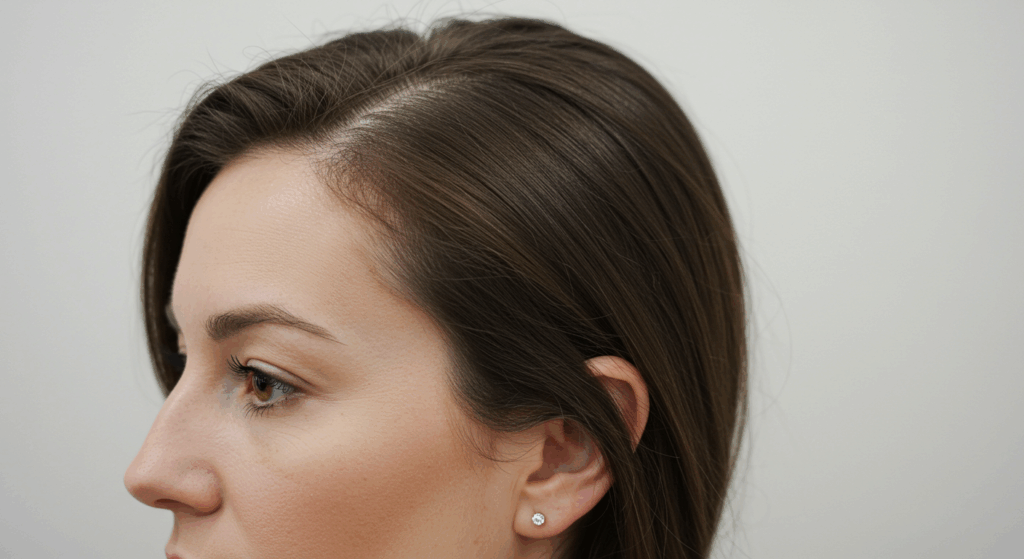Für viele Transgender-Frauen und nicht-binäre Personen, Gesichtsfeminisierung Chirurgie (FFS) ist ein entscheidender Schritt, um das körperliche Erscheinungsbild mit der Geschlechtsidentität in Einklang zu bringen. Zu den transformierendsten Verfahren gehört Haaransatzverlagerung, die die Stirn und den Haaransatz neu formt, um ein weicheres, traditionell feminineres Aussehen zu erzielen. Wie bei jedem chirurgischen Eingriff kommt es jedoch mit Risiken, Herausforderungen bei der Wiederherstellung und wichtige Überlegungen.
Dieser Leitfaden ist Ihr umfassende Ressource zum Verständnis der Risiken, Genesungszeiten und allem, was dazwischen bei der FFS-Haarlinienvergrößerung liegt. Egal, ob Sie sich in der Recherchephase befinden oder sich auf die Operation vorbereiten, wir haben das Richtige für Sie.

Inhaltsverzeichnis
Was ist FFS-Haarlinienvorverlagerung?
Haaransatzverlängerung, auch bekannt als Stirnverkleinerung oder Haarlinienfeminisierungsoperationist ein Verfahren, das dazu dient:
- Senken Sie den Haaransatz, um die Stirnhöhe zu reduzieren.
- Formen Sie den Haaransatz neu, um dem Gesicht einen runderen, feminineren Rahmen zu verleihen.
- Entfernen Sie männliche Brauenwölbungen (hervorstehende Brauenwülste).
Dieses Verfahren wird oft kombiniert mit Augenbrauenlifting oder Förderung der Kopfhaut um optimale Ergebnisse zu erzielen. Für einen tieferen Einblick in die künstlerischen Ansätze zur Haarlinienveränderung lesen Sie unseren Artikel über Unterschiedliche Ansätze zur Haarlinienveränderung bei FFS und FMS.
Die Risiken der FFS-Haarlinienverlagerung: Was Sie wissen müssen
Während die Haarlinienveränderung lebensverändernde Ergebnisse liefern kann, ist es wichtig zu verstehen, potenzielle Risiken und Komplikationen:
Häufige Risiken
| Risiko | Beschreibung | Wahrscheinlichkeit |
|---|---|---|
| Narbenbildung | Sichtbare Narben entlang des Haaransatzes oder der Stirn. Erfahrene Chirurgen minimieren dieses Risiko durch präzise Schnittführung. | Niedrig bis mittel |
| Taubheit | Vorübergehende oder dauerhafte Taubheit in der Stirn oder Kopfhaut aufgrund einer Nervenschädigung. | Mäßig |
| Haarausfall | Vorübergehender Haarausfall oder Ausdünnung um die Schnittstelle. In seltenen Fällen kann es zu dauerhaftem Haarausfall kommen. | Niedrig |
| Infektion | Postoperative Infektionen sind selten, erfordern aber im Falle ihres Auftretens sofortige ärztliche Hilfe. | Niedrig |
| Asymmetrie | Ungleichmäßiger Haaransatz oder ungleichmäßige Stirnform aufgrund der Heilung oder der Operationstechnik. | Niedrig |
Seltene, aber schwerwiegende Komplikationen
- Hämatom: Eine Blutansammlung unter der Haut, die möglicherweise drainiert werden muss.
- Hautnekrose: Seltene, aber schwere Komplikation, bei der Gewebe aufgrund mangelnder Blutversorgung abstirbt.
- Unbefriedigende Ergebnisse: Die Ergebnisse entsprechen möglicherweise nicht den Erwartungen und erfordern eine Revisionsoperation.
Weitere Informationen zu möglichen Komplikationen finden Sie in unserem ausführlichen Leitfaden zu Komplikationen bei der FFS-Operation.
Zeitplan für die Genesung: Was Sie nach der Operation erwartet
Die Erholung von der Haaransatzverlagerung ist ein schrittweiser Prozess das ist individuell unterschiedlich. Unten ist eine Aufschlüsselung nach Wochen was Sie erwartet:
Woche 1: Unmittelbare postoperative Phase
- Tage 1-3: Schwellungen, Blutergüsse und Beschwerden sind häufig. Schmerzmittel und kalte Kompressen helfen, die Symptome zu lindern.
- Tage 4-7: Nähte oder Klammern können entfernt werden. Die Schwellung lässt nach, Blutergüsse können jedoch bestehen bleiben.
Wochen 2–4: Frühe Erholung
- Schwellungen und Blutergüsse nehmen deutlich ab.
- Taubheitsgefühl oder Kribbeln können während der Nervenheilung bestehen bleiben.
- Leichte Aktivitäten können wieder aufgenommen werden, anstrengende Übungen sollten jedoch vermieden werden.
Wochen 5–12: Mittlere Erholung
- Die Schwellungen klingen größtenteils ab und der Haaransatz nimmt seine endgültige Position ein.
- Um die Schnittstelle herum kann es zu Haarneuwuchs kommen.
- Nachsorgetermine zur Überwachung der Heilung und zur Klärung etwaiger Bedenken.
Monate 3-6: Langfristige Heilung
- Das endgültige Ergebnis wird sichtbar, wenn die Schwellung vollständig zurückgeht.
- Narben verblassen und reifen weiter.
- Normalerweise kehrt das volle Gefühl zurück, ein gewisses Taubheitsgefühl kann jedoch bestehen bleiben.
| Zeitraum | Was Sie erwartet | Tipps zur Wiederherstellung |
|---|---|---|
| Woche 1 | Schwellungen, Blutergüsse, Beschwerden | Ruhe, kalte Kompressen, verschreibungspflichtige Schmerzmittel |
| Wochen 2-4 | Verringerte Schwellung, mögliche Taubheit | Vermeiden Sie anstrengende Aktivitäten und halten Sie die Einschnitte sauber. |
| Wochen 5-12 | Der Haaransatz beruhigt sich, das Haarwachstum beginnt | Folgetermine, sanfte Haarpflege |
| Monate 3-6 | Endgültige Ergebnisse, Narben verblassen | Geduld, Narbenpflegeroutinen |
Weitere Tipps zur Verwaltung der Wiederherstellung finden Sie in unserem Leitfaden unter Kontrolle des Haarwachstums nach FFS.

Vorbereitung auf die FFS-Haarlinienverlagerung: Eine Schritt-für-Schritt-Anleitung
Eine gute Vorbereitung ist der Schlüssel zu einer reibungslosen Operation und Genesung. So bereiten Sie sich vor:
Vor der Operation
- Beratung: Besprechen Sie Ihre Ziele, Ihre Krankengeschichte und Ihre Erwartungen mit Ihrem der ChirurgStellen Sie Fragen wie die in unserem Wichtige Fragen zur FFS-Haarliniensenkung.
- Medizinische Untersuchung: Führen Sie alle erforderlichen Bluttests oder Gesundheitsuntersuchungen durch.
- Medikamentenanpassungen: Vermeiden Sie Blutverdünner und bestimmte Nahrungsergänzungsmittel, wie von Ihrem Chirurgen empfohlen.
- Änderungen des Lebensstils: Um die Heilung zu fördern, hören Sie mit dem Rauchen auf und beschränken Sie Ihren Alkoholkonsum.
Tag der Operation
- Vereinbaren Sie, dass ein Freund oder ein Familienmitglied Sie nach Hause fährt.
- Tragen Sie lockere, bequeme Kleidung.
- Befolgen Sie die Anweisungen vor der Operation, z. B. Fasten.
Wichtige Informationen nach der Operation
- Legen Sie sich einen Vorrat an Vorräten wie Mullkompressen, Kühlpackungen und verschreibungspflichtigen Medikamenten an.
- Richten Sie einen komfortablen Erholungsraum mit Kissen, Unterhaltung und einfachem Zugang zu den wichtigsten Dingen ein.
Häufig gestellte Fragen (FAQs)
Ist die Haaransatzverlagerung schmerzhaft?
Die Beschwerden lassen sich in der Regel mit verschriebenen Schmerzmitteln lindern. Die meisten Patienten berichten von leichten bis mittelschweren Schmerzen, die innerhalb einer Woche abklingen.
Werde ich sichtbare Narben haben?
Erfahrene Chirurgen setzen Schnitte entlang des Haaransatzes, um die Sichtbarkeit zu minimieren. Narben verblassen in der Regel mit der Zeit deutlich und können durch Haarstyling kaschiert werden.
Wie schnell kann ich wieder arbeiten?
Die meisten Patienten können, je nach Art ihrer Arbeit und Heilungsverlauf, innerhalb von 1–2 Wochen wieder arbeiten.
Kann ich die Haarlinienverlagerung mit anderen FFS-Verfahren kombinieren?
Ja! Viele Patienten entscheiden sich für eine Kombination aus Haaransatzverlagerung und Eingriffen wie Stirnlifting, Nasenkorrektur, oder Kieferkonturierung für eine umfassende Gesichtsfeminisierung.
Was ist, wenn ich mit den Ergebnissen nicht zufrieden bin?
Eine Revisionsoperation ist eine Option, wenn die Ergebnisse nicht den Erwartungen entsprechen. Eine offene Kommunikation mit Ihrem Chirurgen ist der Schlüssel zum Erreichen des gewünschten Ergebnisses.
Wie pflege ich mein Haar nach der Operation?
Befolgen Sie die Anweisungen Ihres Chirurgen zum Waschen und Stylen Ihrer Haare. Vermeiden Sie Hitzestylinggeräte und aggressive Chemikalien, bis Ihr Chirurg dies genehmigt hat. Weitere Tipps finden Sie in unserem Leitfaden zu Kontrolle des Haarwachstums nach FFS.
Gibt es nicht-chirurgische Alternativen?
Nicht-chirurgische Optionen wie Haartransplantationen oder Füllstoffe können zwar vorübergehende Verbesserungen bieten, liefern aber in der Regel nicht die gleichen dramatischen Ergebnisse wie eine Operation.
Welche Fragen sollte ich meinem Chirurgen stellen?
Bereiten Sie eine Liste mit Fragen vor, wie beispielsweise in unserem Wichtige Fragen zur FFS-Haarliniensenkung Leitfaden, um sicherzustellen, dass Sie umfassend informiert sind.
Fazit: Ihr Weg zum Selbstvertrauen
Wichtigste Erkenntnisse
- Die FFS-Haarlinienverstärkung ist ein wirksames Mittel, um ein feminineres Aussehen zu erreichen.
- Für ein erfolgreiches Ergebnis ist es wichtig, die Risiken und den Genesungsprozess zu verstehen.
- Eine angemessene Vorbereitung und Nachsorge können Ihre Ergebnisse erheblich verbessern.
- Durch eine offene Kommunikation mit Ihrem Chirurgen wird sichergestellt, dass Ihre Erwartungen mit der Realität übereinstimmen.
Nächste Schritte
- Vereinbaren Sie einen Beratungstermin mit einem qualifizierten FFS-Chirurgen, um Ihre Ziele zu besprechen.
- Überprüfen Sie unsere Häufig gestellte Fragen zur FFS-Chirurgie für weitere Einblicke.
- Bereiten Sie sich auf die Operation vor, indem Sie die in diesem Handbuch beschriebenen Richtlinien befolgen.
Besuchen Dr.MFO Instagram-Profil um echte Patiententransformationen zu sehen! Erhalten Sie einen Einblick in die unglaublichen Ergebnisse, die durch Gesichtsbehandlungen erzielt werden Feminisierungschirurgie und andere Verfahren. Das Profil zeigt Vorher-Nachher-Fotos, die hervorheben Dr.MFO's Fachwissen und künstlerische Vision bei der Schaffung natürlich aussehender, schöner Ergebnisse.
Bereit für den nächsten Schritt auf Ihrer Reise? Planen Sie einen kostenlose Beratung mit Dr.MFO ( Bester Chirurg für Gesichtsfeminisierung für Sie) heute. Während der Beratung können Sie Ihre Ziele besprechen, alle Ihre Fragen stellen und mehr darüber erfahren, wie Dr.MFO kann Ihnen helfen, Ihren gewünschten Look zu erreichen. Zögern Sie nicht, diese kostenlose Gelegenheit zu nutzen, um Ihre Optionen zu erkunden und zu sehen, ob Dr.MFO passt zu Ihnen.









